
Park Güell is a privatized park system composed of gardens and architectural elements located on Turó del Carmel, in Barcelona, Catalonia, Spain. Turó del Carmel belongs to the mountain range of Collserola – the Parc del Carmel is located on the northern face. Park Güell is located in La Salut, a neighborhood in the Gràcia district of Barcelona. With urbanization in mind, Eusebi Güell assigned the design of the park to Antoni Gaudí, a renowned architect and the face of Catalan modernism.
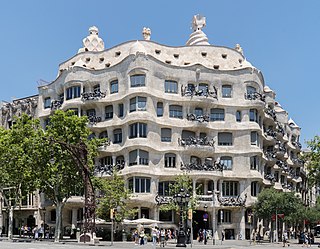
Casa Milà, popularly known as La Pedrera in reference to its unconventional rough-hewn appearance, is a Modernista building in Barcelona, Catalonia, Spain. It was the last private residence designed by architect Antoni Gaudí and was built between 1906 and 1912.

The Basílica i Temple Expiatori de la Sagrada Família, otherwise known as Sagrada Família, is a church under construction in the Eixample district of Barcelona, Catalonia, Spain. It is the largest unfinished Catholic church in the world. Designed by Catalan architect Antoni Gaudí (1852–1926), in 2005 his work on Sagrada Família was added to an existing (1984) UNESCO World Heritage Site, "Works of Antoni Gaudí". On 7 November 2010, Pope Benedict XVI consecrated the church and proclaimed it a minor basilica.
This is a timeline of architecture, indexing the individual year in architecture pages. Notable events in architecture and related disciplines including structural engineering, landscape architecture, and city planning. One significant architectural achievement is listed for each year.
The year 1889 in architecture involved some significant events.
The year 1936 in architecture involved some significant events.
The year 1852 in architecture involved some significant architectural events and new buildings.
The year 1894 in architecture involved some significant events.

Casa Vicens is a modernist building situated in the Gràcia neighbourhood of Barcelona. It is the work of architect Antoni Gaudí and is considered to be his first major project. It was built between 1883 and 1885, although Gaudí drew up the initial plans between 1878 and 1880. The work belongs to the orientalist style, similar to Neo-Mudéjar architecture, although interpreted in Gaudí’s own personal way, with a uniqueness that only he knew how to add to his projects. In this work, and for the first time, Gaudí outlined some of his constructive resources that would become regular features throughout the emergence of Modernisme. The work was widely discussed when it was built and caused a great sensation among the general public at the time. When the building was constructed, Gràcia was still an independent urban nucleus of Barcelona; it had its own council and was classified as a town, though nowadays it is a district of the city.
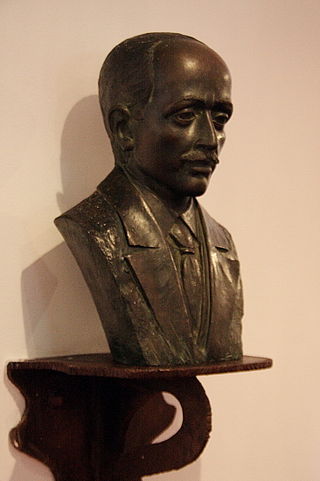
José María Jujol Gibert was a Catalan Spanish architect. Jujol's wide field of activity ranged from furniture designs and painting, to architecture. He worked with Antoni Gaudí on many of his most famous works. Among Jujol's projects are Casa Batlló, Casa Milà, Park Güell, and Our Lady of Montserrat, and among his design styles are Modernisme and Art Nouveau.
The year 1882 in architecture involved some significant architectural events and new buildings.

The Church of Colònia Güell is an unfinished work by Antoni Gaudí. It was built as a place of worship for the people on a hillside in a manufacturing area in Santa Coloma de Cervelló, near Barcelona. Colònia Güell was the brainchild of Count Eusebi de Güell; who enlisted the help of architect Antoni Gaudí in 1898. However, work was not started until 1908, 10 years after commission. The plan for the building consisted of constructing two naves, an upper and a lower, two towers, and one forty-meter-high central dome. In 1914, the Güell family halted construction due to the death of Count Güell. At the time, the lower nave was almost complete so between the years of 1915 and 1917, it was completed and readied for use.

An unfinished building is a building where construction work was abandoned or on hold at some stage or only exists as a design. It may also refer to buildings that are currently being built, particularly those that have been delayed or at which construction work progresses extremely slowly.
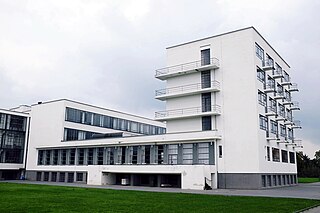
The New Objectivity is a name often given to the Modern architecture that emerged in Europe, primarily German-speaking Europe, in the 1920s and 30s. It is also frequently called Neues Bauen. The New Objectivity remodeled many German cities in this period.

Joan Martorell i Montells was a Catalan architect and designer. He was an uncle of the architect Bernardí Martorell i Puig.
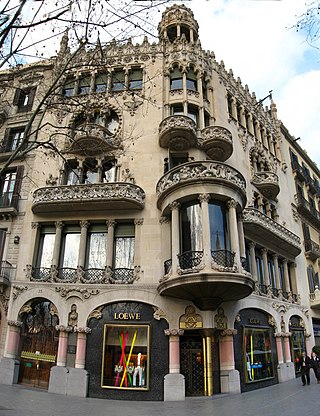
The Casa Lleó Morera is a building designed by noted modernisme architect Lluís Domènech i Montaner, located at Passeig de Gràcia 35 in the Eixample district of Barcelona. In 1902 Francesca Morera assigned Lluís Domènech i Montaner to remodel ancient "casa Rocamora", built in 1864. She died in 1904, and the building was named after her son, Albert Lleó i Morera. The building is located on the corner of Carrer del Consell de Cent, and is one of the three important buildings of Barcelona's Illa de la Discòrdia, and it is the only building of the block awarded Barcelona's town council's Arts Building Annual Award, obtained in 1906. The building lost some of its most representative elements, such as the tempietto on its top and the ground floor and mezzanine's architectural sculpture. The building is also known as the residence of Cuban-Catalan photographer Pau Audouard.
Ernst Neufert was a German architect who is known as an assistant of Walter Gropius, as a teacher and member of various standardization organizations, and especially for his widely disseminated reference book Architects' data.
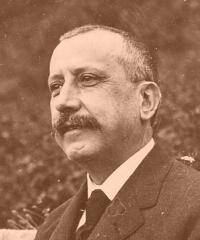
Joan Rubió y Bellver was a Spanish architect famous for his contributions to the Catalan Modernista movement.
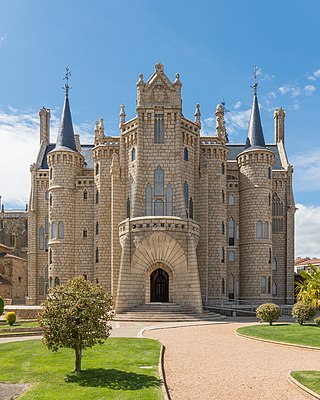
The Episcopal Palace of Astorga is a building by Catalan architect Antoni Gaudí. It was built between 1889 and 1913. Designed in the Catalan Modernisme style, it is one of only three buildings by Gaudí outside Catalonia.

Antoni Gaudí i Cornet was a Spanish architect and designer from Catalonia, known as the greatest exponent of Catalan Modernism. Gaudí's works have a sui generis style. Most are located in Barcelona, including his main work, the Sagrada Família church.















